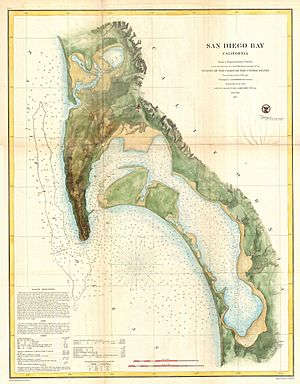Ballast Point Lighthouse facts for kids
| Location | Point Loma, California |
|---|---|
| Coordinates | 32°41′11.0″N 117°13′57.0″W / 32.686389°N 117.232500°W |
| Year first constructed | 1890 |
| Deactivated | 1960 (Demolished) |
| Tower shape | Square |
| Height | 34 foot (10 m) |
| Original lens | Fifth order Fresnel lens |
| Characteristic | Fixed White |
The Ballast Point Lighthouse was once an important lighthouse in San Diego, California. It stood on Ballast Point, a small piece of land reaching into San Diego Bay from Point Loma. This lighthouse was taken down in 1960. Today, the area is part of the Naval Base Point Loma.
The Ballast Point Lighthouse was special because it was the last lighthouse on the Pacific coast to show a steady, unblinking light. Now, an automated light works in its place. This new light is on a piling in the water near where the old lighthouse used to be.
Contents
History of Ballast Point Lighthouse
Ballast Point is a small peninsula that stretches from Point Loma. It sits right at the entrance to San Diego's harbor. The name "Ballast Point" comes from a long time ago. Early sailors from places like Boston would collect stones from this point. They used these stones as ballast to balance their ships. This was especially important for their long journeys back home around Cape Horn.
Early Explorers and Settlements
In 1542, Juan Rodríguez Cabrillo sailed from Mexico. After five months, he saw the Coronado Islands. He then found the land of Point Loma. Cabrillo sailed past the kelp beds and anchored his ship. He stayed for six days in the calm waters near Ballast Point. He named this large harbor San Miguel.
Sixty years later, in 1602, Sebastián Vizcaíno arrived. He anchored his ship on November 10. Vizcaíno renamed the harbor San Diego. He did this to honor a saint whose feast day it was.
By 1769, Spain decided to settle this area. They wanted to teach the local people new skills and the Catholic faith. Ships began bringing supplies. In 1795, a ship called the Aranzaya brought workers and wood. They built a fort at Ballast Point, which was then known as Point Guijarros.
Whaling and the First Lighthouse
People in this area also hunted whales. Whales would come close to shore, making it easier to catch them. The whale bodies were brought to Ballast Point. There, their blubber (fat) was boiled in large pots. This process made oil.
The first Ballast Point Lighthouse was built in 1890. It included two homes and a light tower. The tower was actually part of the keeper's living quarters. The light used a special Fresnel lens and had a green shade. It shone a steady light from 34 feet (10 m) above the water. The tower itself was a white square shape.
Changes to the Lighthouse
In June 1960, the old homes were taken down. This left the light tower standing alone. However, during repairs, workers found the tower was not stable. Its brick and mortar foundation was failing.
The Ballast Point Lighthouse was not completely lost in the 1960s. After the tower was removed, its lantern room moved around San Diego County. You can see it today outside the West Sea Company in Old Town. The fog signal tower was also moved in 1961. It now stands at a home in Lakeside, California.
New Lighthouse Structure
Because the old tower was unstable, a decision was made. The light would be moved to the top of the fog signal building. The old tower would then be taken down. The Cabrillo National Monument asked for the lens and light for their museum. They removed the lantern and lens before the tower was demolished.
The new light was different. It used a standard 375 millimetres (14.8 in) lens with special storm panes. This light flashed white, turning off for three seconds and then on for three seconds.
The old light used a 300-watt lamp and gave off 1,700 candlepower. The new light used a slightly smaller 250-watt lamp. But it was much brighter, giving off 9,000 candlepower. This was because of a more efficient bulb and the removal of the green shade.
The fog signal made one loud blast every 15 seconds. If the fog signal ever stopped working, the lighthouse keepers had to ring a large bell by hand. They would ring it once every few seconds. Interestingly, the fog signal had worked perfectly since it was installed in 1926.
Next to the new light structure, new homes were built. These were duplexes with three and four bedrooms. They housed the lighthouse staff and their families. The new light began shining from its new spot on August 5, 1960. The old tower was taken down around that time. Ballast Point was indeed the last lighthouse on the Pacific Coast to have a fixed, steady light.
Current Light at Ballast Point
Today, the only thing left of the original Ballast Point Lighthouse is an automated light. It operates on a piling in the water near Ballast Point. This light is listed as USCG number 6-1570. It shows a white flash every four seconds. A daymark (a sign to help sailors see it during the day) and a fog horn are also part of this modern setup.


